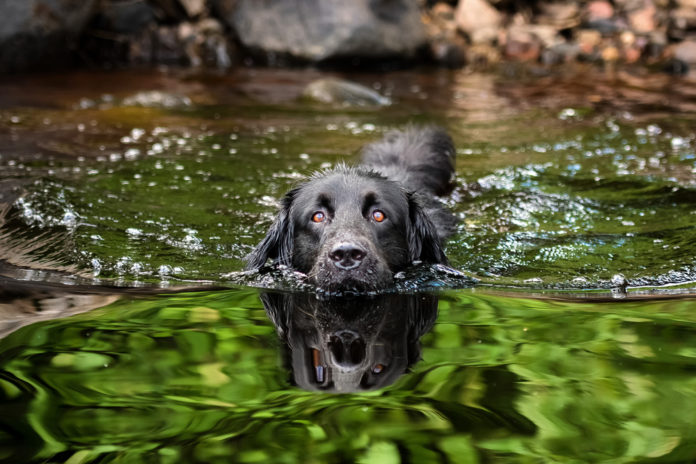Does your dog love the water?

Most dogs love the water, and now that summer’s here, they get a big kick out of wading, splashing and swimming in lakes and streams. Read on for tips to help ensure your aquatic pooch stays safe and healthy.
If your dog loves splashing and playing in the water during the summer, he’s in good company. While some canines prefer to stay dry, many breeds and their mixes are drawn to paddle and swim in lakes, streams and pools as if they were born to it. Retrievers, Labs, Newfoundlands, and many spaniels are among the top water-loving breeds. And aquatic dog sports, like dock diving, paddleboarding, and even surfing, are becoming increasingly popular. Whatever breed/s your water-loving dog may be, and whatever activity he’s involved in, it’s important to consider his safety and well-being both during and after his time in the water. This article covers some key questions to ask before you let him wade into any body of water.
Is the water warm enough?
Depending on where you live, water temperatures can remain cold even in the summer. While breeds from colder regions of the world can swim safely in lower temperatures, even they can get too cold if they stay in the water for long periods. Generally speaking, much like the ambient air temperature, if the water is too cold for you, it is too cold for your dog. “If you feel it’s not warm enough for you to go in, then it’s probably not warm enough for most dogs,” says holistic veterinarian Dr. Patrick Mahaney. It is always best to err on the side of caution and keep your dog out of chilly water to prevent hypothermia.
What are the currents like?
Many dogs will dive into whatever body of water is available, including those where swimming might not be safe. Keep your dog away from any waters where there are strong currents or undertows. Before visiting a potential swimming site with your dog, research it to make sure it’s safe, and pay attention to any signage warning of currents or undercurrents. Be especially wary of rapidly-moving water, and keep your dog ashore.
Is there bacteria in the water?
One unfortunate consequence of swimming in natural bodies of water is the possibility of encountering dangerous bacteria. Dr. Mahaney warns against letter your dog drink from or swim in water that’s stagnant or very shallow: “It could potentially harbor infectious organisms such as Leptospirosis, which could cause severe illness and death. Cyanobacteria is another serious danger. “If the water has any degree of green sheen on the surface or throughout, cyanobacteria (blue-green algae) may be present,” says Dr. Mahaney. “If your dog ingests even a few sips of this water, he could suffer internal organ damage, neurologic problems, and even death.”
Is there dangerous debris on the bottom?
Another risk to watch out for is debris in the water. Be sure that the swimming location does not have sharp objects on the bottom, such as broken glass or metal; even sharp rocks or shells can cut a dog’s paw pads. Also ensure that there’s nothing your dog could get caught on, such as a submerged stump. Ideally, you should be able to see the dog’s feet through the water when he’s swimming. Some bodies of water might also be contaminated with floating or submerged trash, or even chemicals that could be harmful if swallowed. Steer your dog well clear of any unclean water.
How long has he been in the water?
As we know, many dogs are very committed, all-or-nothing creatures that like to play and exercise until they drop. This can pose a danger when it comes to swimming – if your dog enters a large body of water and continues to swim until tired, he may not be able to make it back to land or his starting place in order to rest. “If you’re swimming in any areas where your dog could be compromised, or if you are going out on a boat and/or your dog is not an excellent swimmer, have him wear a canine-appropriate floatation device,” Dr. Mahaney says.
After the swim
After your dog has finished his fun in the water, you need to attend to his coat, skin, eyes, ears and paws to make sure they’re clean and undamaged.
- Rinse your dog off to remove any algae, contaminants, chlorine, salt, and other substances found in many bodies of water.
- Your dog should be thoroughly dried as well, especially beneath his harness.
- Caring for your dog’s ears after a swim is essential. “The ears are a susceptible place where moisture, darkness, and warmth create a microenvironment that promotes the growth of bacteria and yeast,” says Dr. Mahaney. “Performing an ear flush with a veterinary-prescribed ear cleaning solution after each swim is an appropriate way to reduce the potential for ear infections, and remove allergens and environmental debris.” Gently drying your dog’s ears will help reduce the chances of infection from residual water.
- Your pup’s paws are paramount when swimming. He needs to use them to paddle and propel himself through the water. To keep his feet healthy and kicking, be sure they are also rinsed and dried after his time in the water. Bacteria, yeast, and even debris can hide between the toes and around the pads, so it’s important to rinse and then gently dry them.
- During a swim, your dog’s eyes may encounter dirt, algae, or irritants such as chlorine. “When undesirable things get on the tear film, put in some irrigating eye wash, like saline, such as you would use in your own eyes,” advises Dr. Mahaney. “Be sure to just use pure saline solution without any chemicals intended to reduce eye redness.” Depending on the situation, wiping your dog’s eyes gently with a soft towel is another good option. Inspect his eyes and make sure they look healthy, clear, and are not bloodshot. If there is any indication of injury, call your veterinarian to arrange for a physical examination.
By answering the questions presented in this article, you can help ensure your dog’s water activities will be safe as well as fun. It’s also important to check him over and clean him up after his time in the water. Safe swimming!



